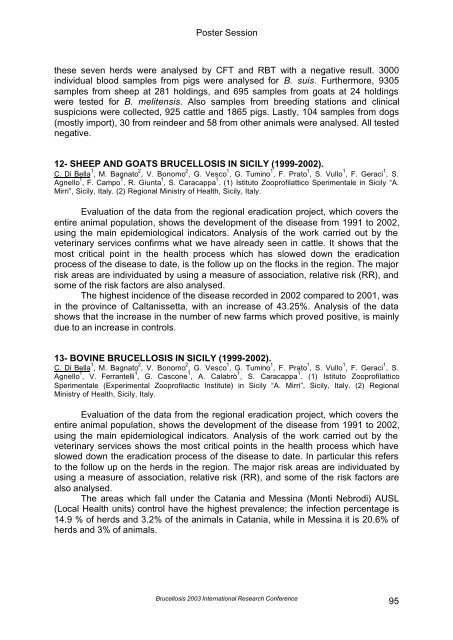Brucellosis 2003 proceedings - PHIDIAS
Brucellosis 2003 proceedings - PHIDIAS
Brucellosis 2003 proceedings - PHIDIAS
Create successful ePaper yourself
Turn your PDF publications into a flip-book with our unique Google optimized e-Paper software.
Poster Session<br />
these seven herds were analysed by CFT and RBT with a negative result. 3000<br />
individual blood samples from pigs were analysed for B. suis. Furthermore, 9305<br />
samples from sheep at 281 holdings, and 695 samples from goats at 24 holdings<br />
were tested for B. melitensis. Also samples from breeding stations and clinical<br />
suspicions were collected, 925 cattle and 1865 pigs. Lastly, 104 samples from dogs<br />
(mostly import), 30 from reindeer and 58 from other animals were analysed. All tested<br />
negative.<br />
12- SHEEP AND GOATS BRUCELLOSIS IN SICILY (1999-2002).<br />
C. Di Bella 1 , M. Bagnato 2 , V. Bonomo 2 , G. Vesco 1 , G. Tumino 1 , F. Prato 1 , S. Vullo 1 , F. Geraci 1 , S.<br />
Agnello 1 , F. Campo 1 , R. Giunta 1 , S. Caracappa 1 . (1) Istituto Zooprofilattico Sperimentale in Sicily “A.<br />
Mirri”, Sicily, Italy. (2) Regional Ministry of Health, Sicily, Italy.<br />
Evaluation of the data from the regional eradication project, which covers the<br />
entire animal population, shows the development of the disease from 1991 to 2002,<br />
using the main epidemiological indicators. Analysis of the work carried out by the<br />
veterinary services confirms what we have already seen in cattle. It shows that the<br />
most critical point in the health process which has slowed down the eradication<br />
process of the disease to date, is the follow up on the flocks in the region. The major<br />
risk areas are individuated by using a measure of association, relative risk (RR), and<br />
some of the risk factors are also analysed.<br />
The highest incidence of the disease recorded in 2002 compared to 2001, was<br />
in the province of Caltanissetta, with an increase of 43.25%. Analysis of the data<br />
shows that the increase in the number of new farms which proved positive, is mainly<br />
due to an increase in controls.<br />
13- BOVINE BRUCELLOSIS IN SICILY (1999-2002).<br />
C. Di Bella 1 , M. Bagnato 2 , V. Bonomo 2 , G. Vesco 1 , G. Tumino 1 , F. Prato 1 , S. Vullo 1 , F. Geraci 1 , S.<br />
Agnello 1 , V. Ferrantelli 1 , G. Cascone 1 , A. Calabrò 1 , S. Caracappa 1 . (1) Istituto Zooprofilattico<br />
Sperimentale (Experimental Zooprofilactic Institute) in Sicily “A. Mirri”, Sicily, Italy. (2) Regional<br />
Ministry of Health, Sicily, Italy.<br />
Evaluation of the data from the regional eradication project, which covers the<br />
entire animal population, shows the development of the disease from 1991 to 2002,<br />
using the main epidemiological indicators. Analysis of the work carried out by the<br />
veterinary services shows the most critical points in the health process which have<br />
slowed down the eradication process of the disease to date. In particular this refers<br />
to the follow up on the herds in the region. The major risk areas are individuated by<br />
using a measure of association, relative risk (RR), and some of the risk factors are<br />
also analysed.<br />
The areas which fall under the Catania and Messina (Monti Nebrodi) AUSL<br />
(Local Health units) control have the highest prevalence; the infection percentage is<br />
14.9 % of herds and 3.2% of the animals in Catania, while in Messina it is 20.6% of<br />
herds and 3% of animals.<br />
<strong>Brucellosis</strong> <strong>2003</strong> International Research Conference<br />
95
















